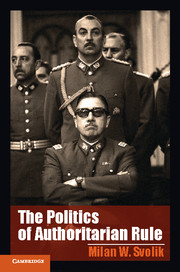Book contents
- Frontmatter
- Contents
- Figures
- Tables
- Acknowledgments
- 1 Introduction: The Anatomy of Dictatorship
- 2 The World of Authoritarian Politics
- PART I THE PROBLEM OF AUTHORITARIAN POWER-SHARING
- PART II THE PROBLEM OF AUTHORITARIAN CONTROL
- 5 Moral Hazard in Authoritarian Repression and the Origins of Military Dictatorships
- 6 Why Authoritarian Parties? The Regime Party as an Instrument of Co-optation and Control
- 7 Conclusion: Incentives and Institutions in Authoritarian Politics
- Bibliography
- Index
- Other Books in the Series (continued from page iii)
5 - Moral Hazard in Authoritarian Repression and the Origins of Military Dictatorships
Published online by Cambridge University Press: 05 November 2012
- Frontmatter
- Contents
- Figures
- Tables
- Acknowledgments
- 1 Introduction: The Anatomy of Dictatorship
- 2 The World of Authoritarian Politics
- PART I THE PROBLEM OF AUTHORITARIAN POWER-SHARING
- PART II THE PROBLEM OF AUTHORITARIAN CONTROL
- 5 Moral Hazard in Authoritarian Repression and the Origins of Military Dictatorships
- 6 Why Authoritarian Parties? The Regime Party as an Instrument of Co-optation and Control
- 7 Conclusion: Incentives and Institutions in Authoritarian Politics
- Bibliography
- Index
- Other Books in the Series (continued from page iii)
Summary
The soldan of Egypt, or the emperor of Rome, might drive his harmless subjects, like brute beasts, against their sentiments and inclination: but he must, at least, have led his mamelukes, or praetorian bands, like men, by their opinion.
David Hume, Of the First Principles of Government[Those] emperors who came to power … by corrupting the soldiers … depended solely upon two very uncertain and unstable things: the will and the Fortune of him who granted them the state.
Niccolò Machiavelli, The PrinceOur principle is that the Party commands the gun, and the gun must never be allowed to command the Party.
Mao Zedong, Problems of War and StrategyThe removal or installation of governments by soldiers results in the establishment of a prominent type of authoritarian regime: the military dictatorship. According to the data on institutions and leadership change in dictatorships introduced in Chapter 2, the military was directly or indirectly involved in about 30 percent of all authoritarian governments between 1946 and 2008. Yet what is striking is not only the frequency but also the distribution of military interventions in politics: They tend to recur within the same countries. Thus between 1946 and 2008, soldiers participated in the removal or installation of roughly two of every three Latin American leaders. Meanwhile, the Communist dictatorships of Eastern Europe maintained firm political control over their armed forces throughout most of their existence.
- Type
- Chapter
- Information
- The Politics of Authoritarian Rule , pp. 123 - 161Publisher: Cambridge University PressPrint publication year: 2012

